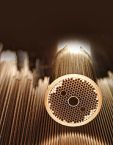

In the Quantum Optics Lab, we work on the quantum interaction of light with atomic ensembles. It means that we work in regimes where the graininess of matter and light becomes important. But it is not always as simple as a bunch of photons being absorbed or emitted by a bunch of atoms. A range of interesting quantum effects arises, including entanglement of particles that can be part of the same object or separated by some distance.
Our technological goal is to integrate hollow-core photonic crystal fibres into an atom chip. Loading a large ensemble of atoms into the hollow core of a fibre will achieve high optical densities and strong quantum mechanical interaction strength. This is essentially due to the tiny cross section of the light beam that can be maintained over a long stretch of light propagation. Our fibres will be mounted on atom chips and then loaded with atoms using magnetic trapping.

Magnetic fields from a micro-structured chip can tightly trap ultra-cold atoms inside a 6 micron fibre core, concentrate them at the centre of the light mode and avoid atom-wall collisions. In order to achieve this, the fibres need to be fixed to the chip surface and be well aligned with the magnetic trapping field. Since deviations must be limited to the sub-micron scale, we use micro-fabricated alignment structures.


Currently, we aim at performing fibre-compatible, non-destructive measurements and quantum state tomography using a new method of probing atoms that we developed recently. This type of measurement can be used in a range of quantum optical experiments, from spin squeezing for the reduction of noise in atomic sensors to producing entanglement over long distances for quantum communication.
Our dispersive measurement technique makes use of the polarization change that light undergoes when it interacts near-resonantly with atoms. By modulating atoms with a radio-frequency (RF) field during detection, we can generate phase-locked signals that circumvent technical low frequency noise. The graph below shows the typical RF response that we detect after producing a quantum superposition of two different internal states, a coherent spin state. We integrate the signal under the temporal mode functions to determine the number of atoms found in the two states. Ultimately, the noise in these populations will be determined by quantum mechanical uncertainty. By producing squeezed spin states and introducing entanglement between different atoms, this can go below the atomic shot noise.


Recently, we applied this method to clock states of rubidium in an atomic cloud released from a magneto-optical trap. We could observe Rabi cycles after illumination with a resonant microwave field. The noise in our data is as low as ~0.2%, see plot on the right.

The next plot shows an example of how we analyse technical and quantum noise contributions to our measurement. By varying the number of probed atoms different types of noise can be separated by their scaling. While quantum noise power (or variance) scales linearly with particle number, technical noise leads to a quadratic dependence. Technical noise can be minimized by choosing experimental parameters that allow for common mode noise suppression. So far, the technical contribution to our phase uncertainty is still 1.2 milliradians. For atoms, photon shot noise contributes a comparable uncertainty, while atomic shot noise contributes only 0.1 milliradians. That means that our noise is almost but not quite as low as the expected atomic noise limit. We are currently limited by technical intensity fluctuations from the two lasers that we use and by a somewhat low optical density. With a few improvements like a low-finesse optical resonator to enhance interaction strength and single laser detection, we expect to achieve atomic shot noise limited detection soon.

You must be logged in to post a comment.